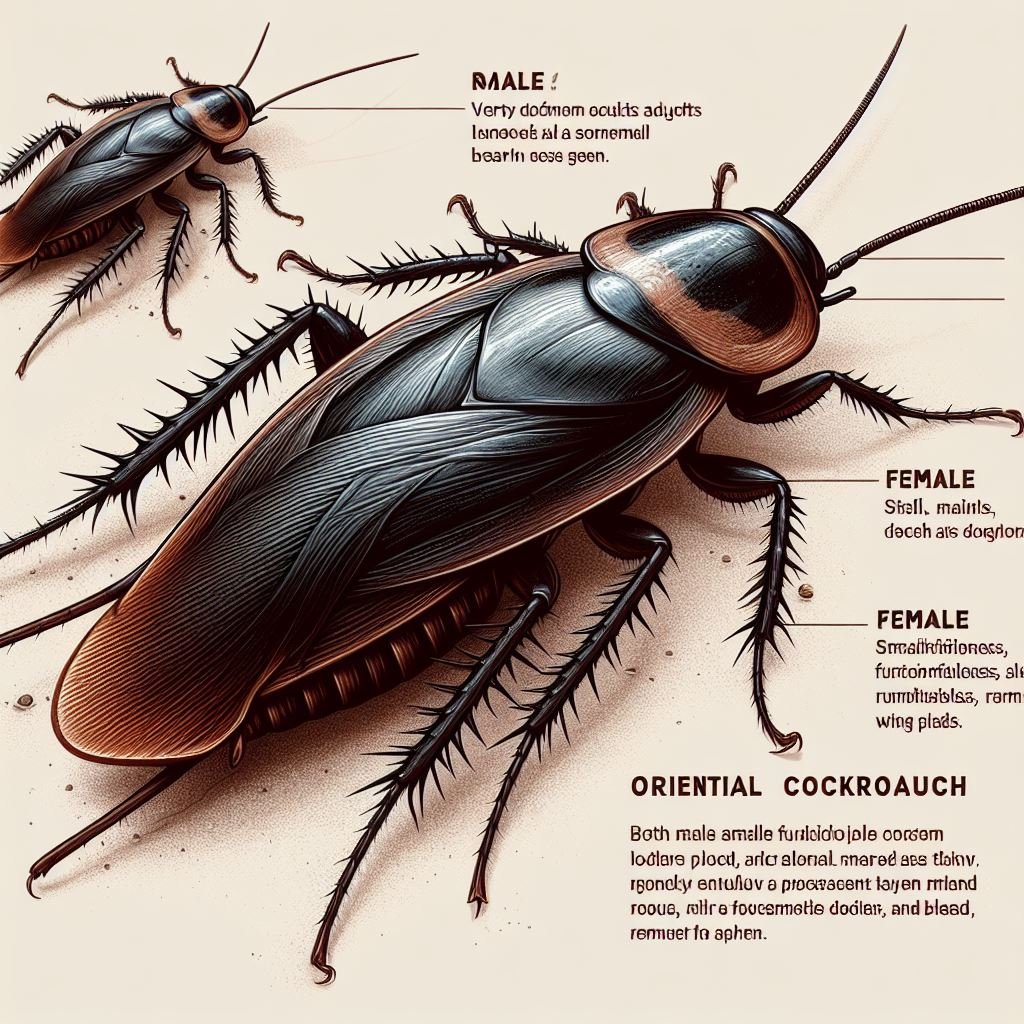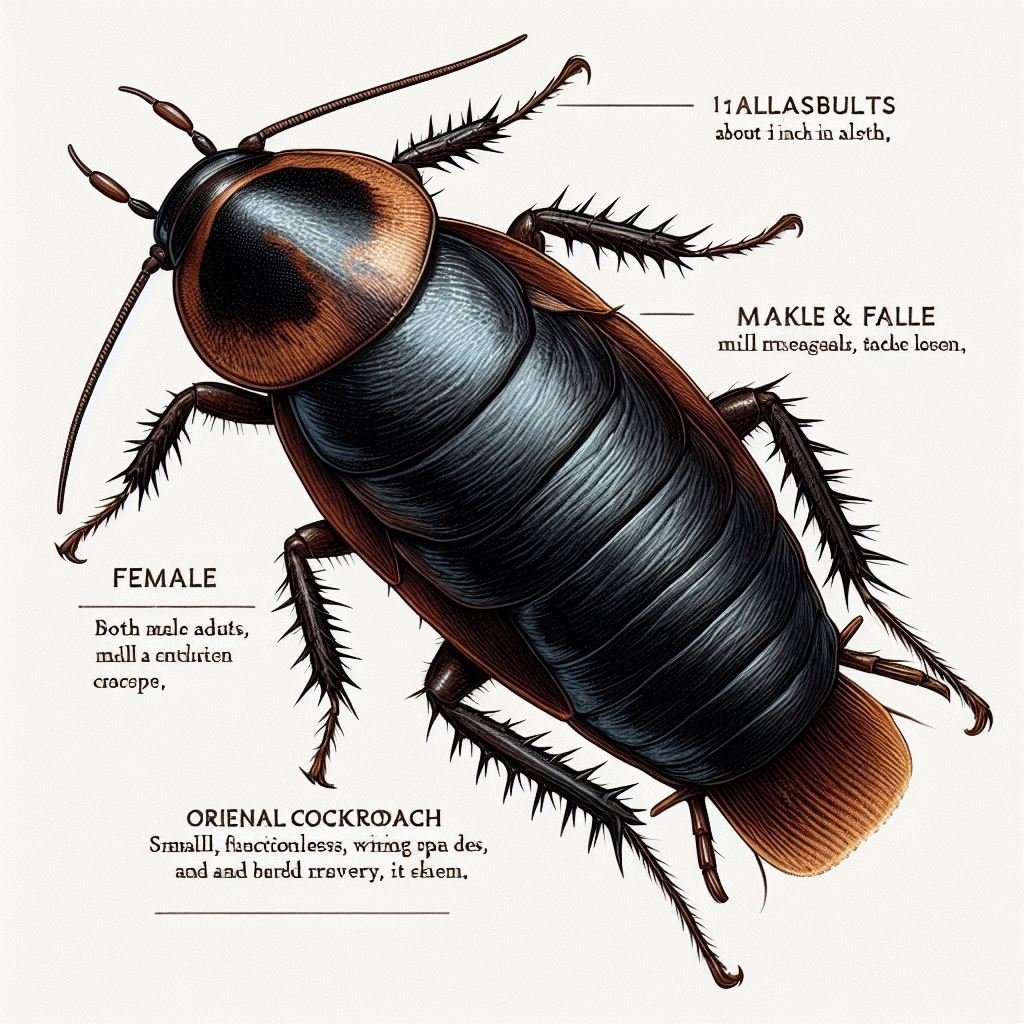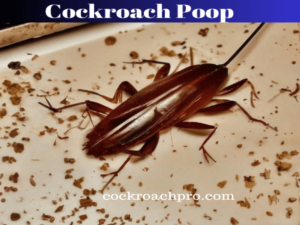The oriental cockroach is one of the most common household pest cockroaches found within homes across many regions.
Often drawn to warm environments with available food and water sources, this species can be difficult to eradicate once established. Identifying key facts about this unpopular insect can help homeowners better understand why it invades and how to get rid of oriental cockroaches once and for all.
At around 1 inch long, oriental cockroaches have large, oval-shaped bodies that are a glossy black or dark brown hue. Their name derives from historical associations with Middle Eastern and Asian shipping vessels originally thought to facilitate their spread.
However, modern research suggests this species originated farther south near North Africa and the Mediterranean coast before global travel enabled expansion into new territories.
Sometimes called waterbugs or black beetles, oriental cockroaches thrive in damp areas like basements, sewers, and drains within households. Here they feed on decaying organic matter and enjoy humid conditions away from light.
During summer periods, orientals may also venture upstairs using drains and pipes in search of food spills inside kitchens and bathrooms. This adaptability makes them highly capable urban survivors.
Perhaps the most unpleasant aspect of an oriental cockroach infestation is the strong odor that accompanies their presence. Caused by a defensive gland secretion, this pungent smell helps deter predators but lingers heavily in areas where populations congregate.
Their droppings also contribute to unpleasant indoor spaces when abundant. Keeping oriental cockroach populations under control is therefore critical for healthy households.
What Are the Signs of an Oriental Cockroach Bite?
When an oriental cockroach accidentally nibbles or probes human skin seeking food sources, the bite itself is not easily visible.
Their small mouthparts create a minor puncture similar to a pinprick that may simply appear as a tiny red dot initially. More noticeable symptoms result from allergic reactions afterward or secondary wound infections.
Allergic Reactions to Bites
Within hours after a bite, those sensitive to components in cockroach saliva often develop larger swollen welts, redness, inflammation, and significant itching at the wound site.
Hives or rashes may also appear on other body parts in extreme cases. Allergy symptoms typically intensify over 48 hours and then slowly subside through medications like antihistamines and topical hydrocortisone creams to help accelerate relief.
Infections from Bites
If oriental cockroach mouthparts introduce bacteria like Salmonella or Shigella species into the bite during feeding attempts, wound infections can develop if left untreated.
Increasing redness, skin warmth, pus-filled blisters, streaks under the skin, and flu-like fatigue or fever signals may indicate a growing infection requiring medical care. Diagnostic tests help identify the bacteria involved to target appropriate antibiotic treatment.
Are Oriental Cockroach Bites Dangerous?
While bite symptoms can be quite uncomfortable and concerning, oriental cockroaches do not transmit any known insect-borne diseases directly through bites or have venomous effects.
Provided those with bite allergies or infection risks seek prompt medical treatment for evaluation and care from a doctor, oriental cockroach bites pose minimal health dangers overall. Practicing good wound hygiene and avoiding bites are ideal.

Why Is the Oriental Cockroach In Your House?
Though considered outdoor pests native to the Indian subcontinent and tropical regions globally, the adaptability and hardy biology of oriental cockroaches allow them to thrive in human homes as well.
Attracted to food, water, and perfect harborage sites, understanding the key reasons behind indoor infestations is critical for prevention and targeted control measures when needed.
1. Access to Food Resources
As scavengers always seeking decomposing organic matter, oriental cockroaches readily consume dropped or spilled human foods indoors as substitutes for their natural fare found in leaf litter and other decaying vegetation outside.
Food particles on unclean dishes, floors, or surfaces sustain cockroach activity, especially when located in their preferred warm, humid sites like within kitchen and bathroom cabinets and basements. Even grease accumulation and sticky spills invite populations to grow rapidly.
2. Available Water Sources
Water is also a critical requirement for cockroach survival and reproduction. Oriental cockroaches prefer damp areas with relative humidity above 75%. Kitchens, bathrooms, and basements often provide not only water spills cockroaches drink but also humid conditions found around pipes beneath sinks where they can gather.
Leaky appliances like dishwashers and drainage problems that lead to standing water offer perfect hydration when needed.
3. Sheltered Harborage Sites
The key to oriental cockroaches thriving indoors is access to harborage where dark, humid conditions offer shelter and aggregate populations. Kitchen cabinets, cracks and crevices along baseboards, access points around pipes, and clutter-like stacks of newspapers or storage boxes all provide ideal harborage.
Basements and crawlspaces with excess cardboard or debris for hiding are also vulnerable areas that can sustain cockroach colonies long-term once established.
6 Tips to Get Rid of Oriental Cockroaches
Eliminating existing oriental cockroaches and clearing infestations requires an integrated pest management (IPM) approach. Combining tactics that address entry access, limit food and water resources, reduce harborage through sanitation, and employ targeted chemical treatments where necessary ensure the best control.
1. Fix Any Plumbing or Water Leaks
Since oriental cockroaches rely heavily on available water sources, fixing any leaky pipes, water heaters, sinks or appliances denies this necessity for population growth. Drainage issues that cause standing water anywhere around the home’s foundation or landscape should also be promptly corrected through physical repairs or improvements.
2. Regular Vacuuming and Eliminating Indoor Clutter
Thorough cleaning that vacuums up existing roaches while eliminating clutter where cockroaches hide and nest is also important. Concentrate efforts in infested areas like basements, kitchens, and bathrooms for best results.
Reduce humidity and limit sheltering spots by removing unneeded cardboard, paper stacks, storage containers, and other debris cockroaches utilize.
3. Apply Boric Acid Powder in Nesting Areas
One of the safest yet effective cockroach control methods is applying boric acid powder into known or suspected nesting areas.
As cockroaches groom themselves and each other, they ingest the boric acid particles which provide long-lasting population control through slow-acting lethality. Focus application of light dust into cracks and crevices, wall voids, beneath appliances and anywhere dark, humid harborage exists.
4. Use Residual Insecticide Sprays in Affected Rooms
For more immediate cockroach knockdown, over-the-counter residual sprays containing synthetic pyrethroid ingredients like cyfluthrin provide decent short-term control indoors.
Treat areas where cockroaches hide, travel, and feed such as along voids and gaps where walls meet floors, around pipe openings, beneath appliances, and inside cabinets. Insecticide performance does diminish over time, however.
5. Deploy Bait Stations and Gels
For ongoing control, using baits and gels boosts the effects of residual sprays so expanding or surviving cockroach populations ingest toxins during exploration and foraging activities.
Place bait stations along walls, by water fixtures, or in corners of cabinets where cockroaches travel most often. Gel baits injected into cracks and crevices work well for population suppression too. Refresh bait placements periodically.
6. Consider Professional Pest Control Support for Heavy Infestations
For the most severe oriental cockroach infestations involving high populations and extensive home access, consider consulting professional pest control experts.
Companies can employ advanced monitoring tools to locate all harborages being utilized, apply commercial-grade insecticides less accessible to homeowners, and conduct complete control of both adult and juvenile life stages through all possible nesting areas both indoors and out. Advanced heat treatments may also be an option where extreme measures are needed.

8 Tips to Prevent Oriental Cockroaches Returning
While eliminating existing oriental cockroaches is important for resolving current household issues, taking dedicated prevention measures minimizes the chances populations easily return later on. A combination of tactics makes homes far less inviting environments.
1. Caulk and Seal Cracks, Crevices, and Possible Entry Points Outside
Because oriental cockroaches are strong climbers capable of scaling walls and other vertical surfaces, sealing up any tiny cracks around windows, doors, pipes or wiring access points greater than 1/16 inch wide denies easy indoor entry from populations living outside.
Use weather sealants, copper mesh, steel wool, or other durable materials that won’t compress or crumble over time. Pay special attention to the structure’s foundation and zones where siding meets brick or stucco.
2. Keep Kitchen, Bathrooms, and Basements Dry
Moisture availability is the key driver encouraging oriental cockroaches to inhabit indoor areas. Fixing plumbing leaks, improving ventilation and dehumidification, repairing water damage, or making drainage corrections all help create less welcoming environments. Run kitchen and bathroom exhaust fans, upgrade to less leaky appliances over time, or take other steps to promote properly dry conditions.
3. Fix Leaky Pipes Promptly
Specifically call immediate attention to any leaky appliances, sump pumps, broken supply lines, or drainage issues allowing puddles or standing water to accumulate in concealed areas like under sinks or inside walls.
Apart from enabling cockroach hydration needs, excess moisture also degrades structures over time. Getting plumbing problems swiftly corrected avoids both pest and property damage long term.
4. Store Firewood Away from Home Exteriors
Another adjustment that discourages oriental cockroaches from gaining indoor footholds includes keeping stacked firewood distant from foundation walls or other external home siding.
Well-seasoned wood stored in covered sheds or open carports avoids direct contact that cockroaches use to access the upper levels of a residence. Any woodpiles already bordering houses should be relocated farther away in yards.
5. Apply Diatomaceous Earth in Potential Harborage Areas
For low-toxicity prevention, apply diatomaceous earth dust in cockroach harborage zones both outside and within homes. Composed mainly of fossilized algae, diatomaceous earth’s tiny sharp edges dehydrate cockroach exoskeletons causing death from water loss over 48 hours of exposure.
Its desiccant effects continue working long-term whenever cockroaches crawl over treated areas. Reapply if dust layers get covered up or washed away.
6. Keep Trash and Recycling Areas Clean
Since cockroaches forage through garbage and waste debris as feeding sites, keeping all outdoor cans tightly closed and free of leaks denies an alternate food source.
Choose cans with tight-sealing lids and clean up any spills promptly. Indoor trash should remain in cans with secure lids rather than using open bags prone to rips or tears. Take garbage and recycling to the curb weekly without allowing overflow.
7. Conduct Regular Inspections for Signs of Returning Cockroaches
Monitor previously infested areas like kitchens, bathrooms, and basements carefully over the weeks following treatment for any signs oriental cockroaches remain or return.
Traps left in place can confirm suspected activity, while vigilance spotting live individuals also helps homeowners respond promptly to avoid heavier renewed infestations. Act quickly at the first signs of lingering cockroaches.
8. Consult Pest Control If Cockroaches Return Anyway
Even utilizing all methods diligently, oriental cockroaches may still occasionally return and require backup support from professional exterminators once again.
Signing ongoing preventative service contracts often guarantees rapid response inspection and retreatments anytime populations resurface. This provides helpful peace of mind should cockroaches manage to regain access and recolonize indoor habitats.
Conclusion
Oriental cockroaches can be extremely challenging to eliminate and keep out of households long term once established given their hardiness and resource adaptability.
But understanding why they successfully inhabit homes and employing targeted integrated pest management techniques both for removal and ongoing prevention gives homeowners the upper hand in protecting their residences.
Leveraging professional pest control support is also wise for severe infestations or anytime additional issues emerge despite diligent self-treatment efforts. With some dedication to these cockroach control tips, homeowners can reclaim oriental cockroach-free living spaces.





